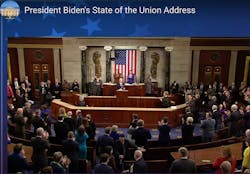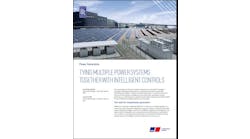What Biden’s State of the Union indicates about the path ahead for microgrids
Federal tax credits for clean energy, which include microgrids, appear to still be in play based on the State of the Union address delivered by President Joe Biden last night.
In the annual speech before Congress, Biden discussed the tax credits in the context of helping Americans economically and battling inflation. He said that combating climate change would cut energy costs for families by an average of $500 a year.
“Let’s provide investments and tax credits to weatherize your homes and businesses to be energy efficient and you get a tax credit; double America’s clean energy production in solar, wind and so much more; lower the price of electric vehicles, saving you another $80 a month because you’ll never have to pay at the gas pump again,” he said.
But how?
It’s unclear, however, exactly how the new and extended clean energy tax credits can win Congressional approval because they are within Biden’s signature Build Back Better legislation that has been blocked by Sen. Joe Manchin, D-W.Va. Negotiations over the legislation appear to be stalled.
The tax credits aside, Biden outlined several other strategies that bode well for microgrid development, among them his efforts to jumpstart electric vehicle (EV) use. He reiterated his goal to build 500,000 electric vehicle charging stations by 2030, which will be aided by $7.5 billion from the bipartisan infrastructure bill that Biden signed into law in November.
“It is worth mentioning that, at the current time, most state governments are researching how to best take advantage of federal money now available to states that develop compliant plans for deployment of EV charging stations,” said Tom Poteet, vice president of corporate development at Mesa Solutions. “Many of those stations will have to be at locations where there is no available electric grid, and thus will be powered by systems that are essentially small microgrids.”
Removing inflationary pressures
The president’s emphasis on lowering costs for Americans — especially energy costs — also opens a door for microgrids. Microgrid champions point to the economics of microgrids as a key selling point, along with the technology’s ability to provide electric reliability and cleaner energy.
“He repeatedly emphasized reducing the cost of everyday expenses working families face —specifically, energy costs. It is important to note the role of microgrids in this endeavor as they can both reduce costs as well as provide a revenue stream for consumers,” said Shalin Shah, marketing lead at Siemens Grid Software in the US.
Shah said that microgrids can reduce costs by efficiently managing energy supply and they can accrue revenue by selling energy and services to the grid.
“This gives consumers a new kind of control in energy markets as they no longer consume energy, but also produce and control it through their microgrids. More advanced microgrids — with intelligent microgrid controls — are also adept at leveraging energy pricing,” Shah said.
Where will solar panels come from?
Biden pushed “Made in America,” a message endorsed by the domestic manufacturers of solar panels, a common component of microgrids.
“US demand for clean energy far outpaces domestic manufacturing capacity. That has to be fixed. Our own domestic supply chain must be capable of supporting a dominant and secure clean energy sector. Federal policy is critical to bridge this gap,” said Abigail Ross Hopper, president and CEO of the Solar Energy Industries Association.
However, the push for domestic manufacturing also leaves “one circle that will be difficult to square,” given that “substantially all solar panels are manufactured in other countries,” said Poteet of Mesa Solutions.
Climate and microgrids
Mark Feasel, president of smart grid North America at Schneider Electric, praised the president’s focus on energy at a time when “we have a once-in-a-generation opportunity to combat climate change.”
“The president is right to focus his administration on the energy transition and fighting climate change, especially considering the tremendous costs of disaster damage every year,” Feasel said. “With the passage of the Bipartisan Infrastructure Law and important clean energy and tax provisions remaining in reconciliation discussions, we have a once-in-a-generation opportunity to combat climate change and rebuild our nation.”
Feasel added: “Resilience, efficiency and sustainability must be at the center of our energy strategy and microgrids are an essential tool to achieve these ends in both the public and private sectors. As a US manufacturer and job creator, we are excited to help achieve our nation’s climate goals and build the digitized 21st century infrastructure we need.”
The address also won praise from Nicole Bulgarino, executive vice president at Ameresco. “We commend the administration’s focus on investments in a clean energy economy to combat climate change. Passing measures that call for increased investments and tax credits will accelerate the move to more energy efficient infrastructure, increased renewable energy generation and electric vehicle adoption. Clean energy investments such as these have the potential to create jobs, increase resiliency through on-site generation and microgrid controls, and ultimately reduce our carbon emissions.”
Learn more about the path ahead for US microgrids. Join Microgrid Knowledge for “Microgrid 2022: Microgrids as Climate Heroes,” June 1-2 in Philadelpha, Pa.
Not enough?
However, some saw the address as disappointing, given that Biden made climate a hallmark of his campaign and first year in office. He consigned it to just a few minutes amid a laundry list of programs and goals in his address.
“President Biden admirably outlined the evil of Russia’s invasion of Ukraine, and made the case that totalitarianism is a clear and present danger for the world community. Mr. President, you missed the mark on the clear and present danger that climate change poses to the world as well,” said Jack Griffin, vice president and general manager at SourceOne, a subsidiary of Veolia Energy.
“We welcomed the comments on electrification of the transportation business, but we need more action to ensure our energy transition; investment in wind, solar, storage and the backbone of macro and micro grid resiliency keeps our future safe and prosperous as well,” Griffin added.
Track news about microgrid policy. Subscribe to the free Microgrid Knowledge Newsletter.








